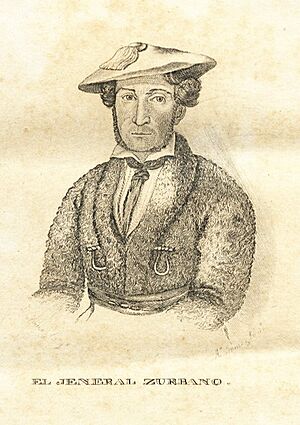Martín Zurbano facts for kids
Martín Zurbano Baras (born February 29, 1788 – died January 21, 1845) was an important Spanish military leader. He was a brave guerrilla fighter and is remembered as a "martyr to Spanish liberty." This means he died fighting for freedom in Spain.
Contents
Early Life and Fighting for Spain's Freedom
Martín Zurbano was born in Varea, a town in La Rioja, Spain. He was the youngest of four children.
He became a fighter during the War of Spanish Independence. This war was fought when France invaded Spain. Zurbano was a guerrilla leader, meaning he led small groups of fighters who used surprise attacks. He fought alongside other future generals, like Francisco Espoz y Mina.
Zurbano helped defend the Constitution of 1812. This was a very important set of rules for Spain. He also helped create the province of Logroño in his home region.
Fighting in the Carlist War
After the War of Independence, Zurbano fought in the First Carlist War. He was on the Liberal side, which supported Queen Isabel II. During this war, he became a very high-ranking officer, reaching the rank of field marshal.
In 1833, Zurbano started a special fighting group called the Compañía de Tiradores de Alava. This group later joined with another and became known as the Partida de la Muerte (Party of Death). This name showed how determined and fierce they were in battle. By 1836, his force was known as the Batallón de Voluntarios de la Rioja Alavesa. This group was officially ended in 1840.
Political Connections and Later Battles
Martín Zurbano was a strong supporter of Baldomero Espartero. Espartero was another powerful general and politician. Because of Zurbano's loyalty, Espartero gave him important jobs. In 1840, Zurbano became the military governor of Girona and the commander general of Biscay.
Zurbano also took part in important battles. For example, he was involved in the bombardment of Barcelona in 1843. He also fought against other political groups, like the moderado faction in Biscay in 1841. He later fought against another general, Juan Prim, in Catalonia in 1843.
Final Revolt and Execution
When Espartero lost power, Zurbano had to flee to Portugal. However, Queen Isabel II later granted him a pardon, which meant she forgave him.
In 1844, Zurbano led a new revolt. He and about 80 men wanted to bring back the Spanish Constitution of 1837 and have Espartero return to power. This revolt was known as the Grito de Nájera. Some important generals, including Juan Prim, supported him.
However, Zurbano was arrested by Ramón María Narváez, who was a powerful political figure. Martín Zurbano was then executed by a firing squad. His sons, Benito and Feliciano, were also executed with him, by order of Narváez.
Images for kids
See also
 In Spanish: Martín Zurbano para niños
In Spanish: Martín Zurbano para niños





